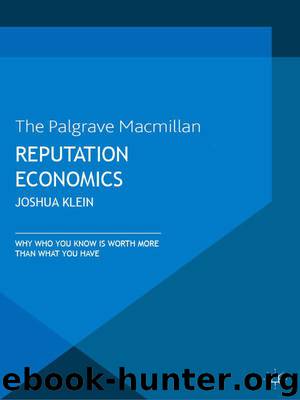Reputation Economics: Why Who You Know Is Worth More Than What You Have by Joshua Klein

Author:Joshua Klein [Klein, Joshua]
Language: eng
Format: mobi
ISBN: 9781137387011
Publisher: Palgrave Macmillan
Published: 2013-11-04T14:00:00+00:00
# COMPLEX MODELS, FULL OF FAIL
Consider the weather. Everyone always wonders why meteorologists can’t get the whole rain / no rain thing right, but in fact they’re dealing with an enormously complex system of interconnected elements. But what if you took a simplified situation? Instead of dealing with a mishmash of interplaying microclimates, like the middle of a city, what about the middle of the ocean?
Air France Flight 447, an Airbus 330–200 with 228 people on board, crashed off the Brazilian coast on June 1, 2009, in the Atlantic Ocean in an area where the water is 4,000 meters deep. Put another way, it wasn’t a spectacularly complex weather environment. Ordinarily, officials would use a concentric circling method to slowly spiral outward from the last-known or best-guess location to find the plane. It’s a technique that’s been used for centuries, but in this case French officials decided to do better.6
That summer, the French Bureau d’Enquetes et d’Analyses (BEA) contracted renowned oceanographers and mathematicians from France, Great Britain, the United States, and Russia to model the likely location of the crash area to determine where the plane was. They based their model on the drift of the bodies and pieces of the wreckage that had been found on June 6, north of the Last Known Position (LKP). The highly complex calculations took into account currents, wind, and waves and were summed up into a limited 2,000 sq. km probable crash area extending 60 km north of the LKP. The entire effort cost more than $30 million. The result of all this hard work was that they searched in the wrong area for almost two years.
The actual site of the wreckage was only 10 km from the LKP. It was found in late March 2011 when the French Marines, who had placed electronic buoys and monitored them for weeks, found that currents in fact behaved unpredictably and changed very often. The modelers had made wrong assumptions, sending would-be rescuers on a wild goose chase. Now keep in mind that these top minds only had to model 2,000 sq. km for a period of five days, using all the detailed mapping and weather information you would expect a major First World government to be able to provide.
Again, they failed because of their assumptions, which, while enormously well educated, researched, and peer reviewed, were also completely wrong.
It’s not just in well-funded government projects that weather models get it wrong. Ross McKitrick of the University of Guelph, an expert reviewer for the UN’s Intergovernmental Panel on Climate Change, did an examination of a cadre of major studies attempting to verify weather models. What he learned was that almost all of them were complete and utter shit.7
For example, a team of hydrologists at the National Technical University of Athens published a pair of studies in 2008 and 2010 comparing long-term (100-year) temperature and precipitation trends in 55 locations around the world to model projections. The models performed terribly at the annual level, but did equally bad even when averaged up to the 30-year scale, which is the level they were supposed to work best at.
Download
This site does not store any files on its server. We only index and link to content provided by other sites. Please contact the content providers to delete copyright contents if any and email us, we'll remove relevant links or contents immediately.
Influence: The Psychology of Persuasion by Robert B. Cialdini(4737)
The Miracle Morning by Hal Elrod(4675)
The Hacking of the American Mind by Robert H. Lustig(4338)
Pre-Suasion: A Revolutionary Way to Influence and Persuade by Robert Cialdini(4184)
Unlabel: Selling You Without Selling Out by Marc Ecko(3625)
Ogilvy on Advertising by David Ogilvy(3553)
Hidden Persuasion: 33 psychological influence techniques in advertising by Marc Andrews & Matthijs van Leeuwen & Rick van Baaren(3519)
Purple Cow by Seth Godin(3168)
Who Can You Trust? by Rachel Botsman(3111)
Kick Ass in College: Highest Rated "How to Study in College" Book | 77 Ninja Study Skills Tips and Career Strategies | Motivational for College Students: A Guerrilla Guide to College Success by Fox Gunnar(3100)
The Marketing Plan Handbook: Develop Big-Picture Marketing Plans for Pennies on the Dollar by Robert W. Bly(3006)
This Is Marketing by Seth Godin(2993)
I Live in the Future & Here's How It Works by Nick Bilton(2960)
The Power of Broke by Daymond John(2932)
The Tipping Point by Malcolm Gladwell(2870)
Building a StoryBrand by Donald Miller(2863)
The 46 Rules of Genius: An Innovator's Guide to Creativity (Voices That Matter) by Marty Neumeier(2818)
Draw to Win: A Crash Course on How to Lead, Sell, and Innovate With Your Visual Mind by Dan Roam(2756)
Market Wizards by Jack D. Schwager(2671)
